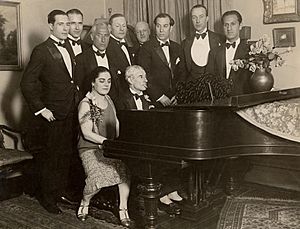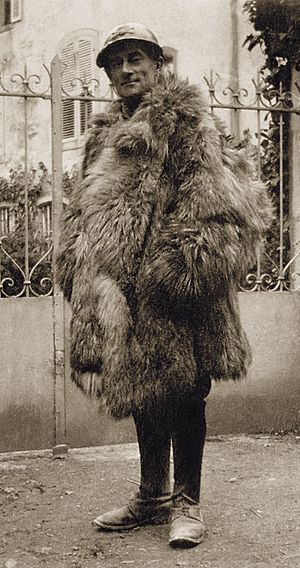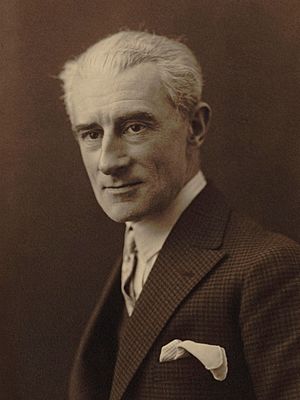Maurice Ravel facts for kids
Maurice Ravel (born in Ciboure, France, on March 7, 1875; died in Paris, France, on December 28, 1937) was a famous French composer. His music is often compared to Claude Debussy's, but they were quite different. Ravel loved children and animals, and his music often shows this. He enjoyed writing about fairy tales and stories from faraway lands. He created beautiful piano music, though much of it is tricky to play. One of his most famous pieces is Boléro, a 17-minute orchestral work. A shorter version of Boléro was used by ice-skaters Torvill and Dean when they became Olympic champions in 1984.
Contents
His Life Story
Early Years and Music School
Maurice Ravel was born in Ciboure, a town in France. His father was an engineer. Both of his parents loved culture and the arts. Soon after Maurice was born, his family moved to Paris and lived there permanently.
It quickly became clear that Maurice had a special gift for music. His father arranged for him to have piano lessons with a well-known teacher. In 1889, Maurice joined the famous Paris Conservatoire, a top music school.
In 1889, Paris hosted a huge international event called the World Exhibition. Both Ravel and Debussy heard gamelan music from Java at this exhibition. This unique music, played on instruments like gongs and drums, influenced both composers, especially Debussy. Ravel also heard Russian music at concerts by Nikolai Rimsky-Korsakov. He also became friends with a very talented Spanish pianist named Ricardo Viñes, who was in the same class at the Conservatoire. Ravel also learned about the music of Richard Wagner and met composers like Chabrier and Erik Satie.
Ravel left the Conservatoire in 1895 but returned in 1897. This time, he studied composition with Gabriel Fauré and learned about counterpoint and orchestration. At first, Ravel wasn't very confident in his own composing. His first piece to become famous was a short orchestral work called Pavane pour une infante défunte. Fauré was a great teacher for Ravel, who dedicated his difficult piano piece Jeux d’eau (meaning “Play of water” or “Fountains”) and his String Quartet to Fauré. However, Ravel never won a prize for composition, so he left Fauré’s class in 1903.
Starting His Career
Ravel began to live like a "dandy," which meant he always dressed very smartly and enjoyed being fashionable. He became friends with people who shared his interests. He tried to win the important Prix de Rome music prize in 1904 and again in 1905. However, the judges preferred traditional music and didn't understand Ravel's new style. This caused a big argument at the Conservatoire. The director, Dubois, ended up leaving, and Fauré took his place. Meanwhile, Ravel left Paris for a while with friends. During this time, he started writing some of his best music. These works included Introduction and Allegro for seven instruments, the Rapsodie espagnole for orchestra, his first opera L’heure espagnole, and Gaspard de la Nuit, a very challenging piano piece. Back in Paris, music critics continued to debate about Ravel’s music.
Finally Recognized

In 1909, the famous Ballets Russes dance company visited Paris. Their director, Sergei Diaghilev, asked Ravel to write a ballet for them. It took Ravel about three years to compose the music for Daphnis et Chloé. Other works he finished before World War I started included Shéhérazade for a soprano singer and orchestra, and the Piano Trio.
World War I and Its Impact

When World War I began, Ravel strongly wanted to help his country. However, he was not allowed to join the French army because he was slightly underweight. So, he became a driver for the motor transport corps, driving trucks. In 1916, he became very ill with dysentery. After spending time in the hospital, he returned to Paris to recover. Then, his mother died, which deeply affected him. The war years made it harder for him to compose. He did write Le Tombeau de Couperin, a well-known piece for piano and orchestra that sounds like music from the Baroque period. It also took him a long time to finish La Valse (The Waltz), which became one of his most popular pieces.
After the War
After the war ended, Debussy had passed away, and Ravel was seen as the greatest living French composer. He was offered the important Légion d’honneur award, but he chose not to accept it. He bought a house outside Paris where he could compose in peace and quiet. There, he wrote his opera L’enfant et les sortileges (The child and magic) and the famous and difficult piece for solo violin called Tzigane. He traveled and performed in Europe and the United States, where he was celebrated as a great composer. He even received an honorary doctorate from Oxford University in England.
Ravel worked on several new projects, including some ballet music that became the orchestral piece Boléro. He also wrote a Piano Concerto in G, and a special Piano Concerto for the Left Hand. This last piece was written for pianist Paul Wittgenstein, who had lost his right arm in the war, so it could be played using only the left hand. Ravel also started other projects that he didn't get to finish.
His Final Years
In 1932, Ravel began to get sick. He had a brain operation in 1937, but sadly, he passed away later that year.
Ravel's Music Style
Ravel was a very private person. His musical ideas often came to him during his walks alone, whether in the countryside or in Paris, often at night, and in any weather. Then he would go home and write them down. He worked on each piece until it was perfect and never showed it to anyone until it was completely ready. He loved to collect small things, like toys, and these objects sometimes inspired his music. Old musical styles like Baroque music, gamelan music, Spanish music, ancient modes (types of scales), and unusual harmonies were all important parts of his unique musical style. He had only a few students, including Ralph Vaughan Williams, but no one could truly copy his music. It was always very personal, perfectly crafted, and often full of humor.
Awards and Legacy
Ravel chose not to accept the Légion d'honneur from France, and he also refused other state honors. However, he did accept awards from other countries. These included becoming an honorary member of the Royal Philharmonic Society in 1921, receiving the Belgian Ordre de Léopold in 1926, and an honorary doctorate from the University of Oxford in 1928.
After Ravel's death, his brother Edouard turned the composer's house in Montfort-l'Amaury into a museum. It remains largely as Ravel left it and is open for guided tours today. Many musical works have been dedicated to Ravel or composed in his memory by other famous musicians like Satie and Stravinsky.
Images for kids
-
Gabriel Fauré, Ravel's teacher and supporter
-
Claude Debussy in 1905
-
Michel Fokine as Daphnis in Daphnis et Chloé
-
Original setting for Daphnis et Chloé by Léon Bakst (1912)
See also
 In Spanish: Maurice Ravel para niños
In Spanish: Maurice Ravel para niños











